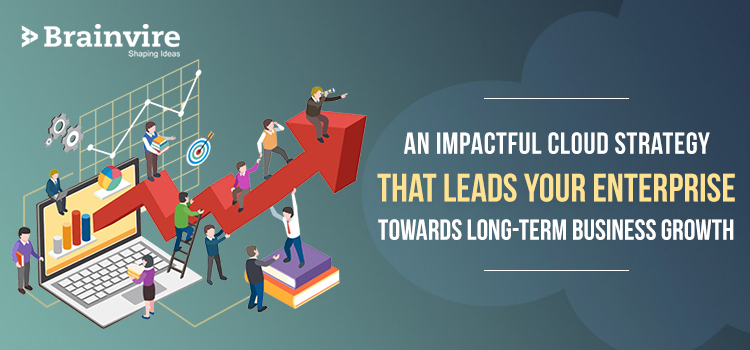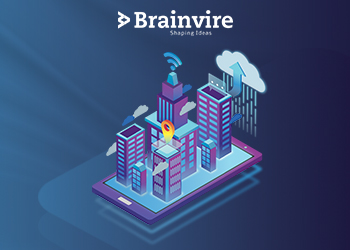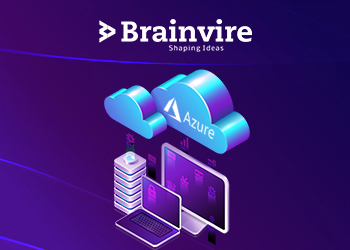
Ready to scale your business applications to the cloud? Or wait. You have already embraced the cloud but are stuck on how to plan for the next steps. Or to be more specific, you think you have done everything right until now on the journey to the cloud but still not getting the promised ROI.
Irrespective of which category you fit in, there is a high chance that you are following a tactical approach to cloud migration. On the contrary, it should be strategic. Let’s understand why this is necessary.
Every organization that wants to migrate to the cloud has different short-term and long-term goals in mind. Different goals mean different challenges. Using tactics might solve such challenges temporarily but they won’t work in the long run. Thus, you need to adopt an impactful and well-defined strategy throughout the journey.
Every cloud journey is unique. However, you need to pass through some common checkpoints to reach your end destination i.e. long-term business growth. They are as follows:
- STRATEGY
- BUSINESS CASE
- OPERATING MODEL
- APPLICATIONS
- INFRASTRUCTURE
- SECURITY
- ORGANIZATION, MANAGEMENT & GOVERNANCE
- OPERATIONS AND MANAGED SERVICES
We’ll discuss how to think strategically when we pass through each of these phases. Let’s begin without any further delay.
STRATEGY
When formulating a cloud strategy, you need to think about many critical issues. These include desired business outcomes, investment priorities, deployment models, service providers, talent sourcing and cloud policies.
When you opt for Microsoft Azure development services, the experts will usually approach the enterprise technology strategy in a layered manner. They will focus on three layers:
- Infrastructure
- Applications
- Operations
It’s important to note that transforming one layer will definitely impact the other layers. You can start developing your strategy with the application layer because of its positive ripple effects on the other layers.
Let me tell you how this actually works in the real world.
When you take applications to the cloud, it reduces the demand for data processing and frees up server space. Thus, it has an impact on the infrastructure (fewer servers are required). This in turn impacts operations. You need to put in less effort to maintain servers and can redirect your resources to more strategic activities.
Besides, you should get in touch with experts who are well-versed with the interdependencies of these three layers. This will further streamline the overall process for you.
BUSINESS CASE
The purpose of a business case is to evaluate traditional financial measures such
as total cost of ownership, return on investment (ROI) and payback period. As a company, you should also evaluate cloud benefits, key performance indicators (KPIs) and value realization. This will maximize shareholder and business value.
Justifying the cloud’s value proposition in the form of a business case has many benefits. It can create new and differentiating capabilities that can enhance a company’s business strategy, drive competitive advantage and improve financial models.
Let’s take a quick look at the business case of a leader in the insurance industry.
Being one of the largest independently owned insurance brokers, the finance firm has grown leaps and bounds through acquisitions. But as it acquired more and more companies, the company’s IT environment mushroomed to include hundreds of different systems, applications, and processes.
This resulted in a fragmented, outdated, unstable and expensive environment. It made collaboration difficult and also affected the customer experience severely.
Thus, the company opted for cloud migration and prepared a comprehensive business case. This helped them to understand the challenges involved in the migration journey and plot a foolproof roadmap for digital transformation.
The journey was completed in a span of 12 months. It connected 4,500 employees and united 300 businesses while generating 30 percent annual savings. Most importantly, it is now better positioned to acquire more companies as part of its rapid expansion plans.
OPERATING MODEL
The Cloud Operating Model represents how an IT organization operates to execute its cloud strategy and deliver value to customers. It provides the building blocks across People, Process and Technology, enabling IT organizations to change
their culture and continuously assess and evolve their critical cloud capabilities as they mature.
An updated operating model is a key to achieving an unprecedented level of operational efficiency. Your model should be able to use cutting-edge technologies and approaches, including robotic process automation (RPA), artificial intelligence (AI), orchestration, workflow, cloud optimization tools, and DevOps.
Is an ‘updated’ operating model really necessary?
Yes, it is.
Enterprises will usually encounter the following challenges when transitioning to the cloud from a legacy system:
- Culture – Organizations need to manage the cultural shift in legacy thinking towards a more agile approach of working with the cloud.
- Skill Gaps – New skills are required to perform new functions, such as cloud migration, machine learning and AI, cloud operations and cloud security. Some new roles may require upskilling, while others may need to be recruited.
- Impact Outside IT – Cloud transformation has a ‘ripple effect’ and impacts other functions outside of IT, such as Finance, HR, Procurement, and others.
- Security and Governance – The cloud introduces new security and governance requirements and capabilities, which need to be addressed to establish controls and minimize risks.
- Strategic Approach – The cloud is always evolving with new technologies and services. Organizations need to visualize what success in the cloud looks like for them, and evolve their strategy to take advantage of their benefits.
- Procurement – Finance and business models need to be adjusted to access the benefits of a new operating model.
Overcoming all of these challenges and adapting to the disruptive changes will not be easy for you. It will pull your attention away from core business objectives. This is where the Cloud Operating Model comes in. By adopting a Cloud Operating Model, you can minimize the impact of disruptive change and accelerate cloud transformation.
APPLICATIONS
This phase includes four approaches that you should consider when migrating to the cloud. They will help you achieve the right endgame. Let’s understand them one by one:
Legacy applications disposition
Needless to say, enterprises have a whole bunch of legacy applications to be migrated to the cloud. Before commencing the actual process, they should look at their entire application portfolio and determine the disposition strategy as well as the timing, order, and grouping of applications being moved to the cloud.
To rapidly and efficiently migrate applications to the cloud, companies should use tools related to application portfolio assessment, application migration templates, and industrialized migration factories.
Application dispositions will determine which functionality becomes a Software-as-a-Service (SaaS), Platform-as-a-Service (PaaS), and which stays as packaged applications to be moved to Infrastructure-as-a-Service (IaaS).
Application migration factory
A cloud migration factory is a collective term referring to the people, processes, and tools that help an organization plan, execute and support workload migrations.
Using this approach, you can choose the best migration approach such as single workload migrations or migrations in phases or groups as well as guide application assessments.
Upon final implementation, the cloud migration factory validates the completed migration to ensure the workload is properly secured and performed adequately. It can also implement any maintenance, backup or disaster recovery tasks needed to support the application in the cloud server.
Modern application architecture
Modern application architecture is a foundation that, once in place, provides a platform for more flexible and agile software development, giving organizations the ability to plan and pivot to address customers’ changing business needs.
Using this approach, enterprises can build systems by integrating various microservices, using container architecture as well as new and growing PaaS capabilities. Decision-makers can also use application development methodologies and approaches to develop, test and rapidly. These include – agile, bi-modal system development life cycle (SDLC) and DevOps.
Thus, enterprises can leverage various components of modern application architecture to gain a competitive advantage. They can continuously and quickly adapt and adjust software applications to changing market trends and customer needs. This, in turn, will positively impact their bottom line.
Next-gen application development
This approach focuses on developing high-value and high-impact cloud-native solutions in the mobile, data science, AI, machine learning and IoT domains.
Cloud-native application development includes custom-built, multi-tenant applications engineered for greater speed, consistency, and reliability. This is accomplished mainly through DevOps services and microservices.
INFRASTRUCTURE
When we think about infrastructure architecture, it’s not restricted to on-premise or cloud. You need to make decisions about IaaS capabilities and services with respect to the network, storage and compute.
Strategies for cloud infrastructure architecture should ensure proper infrastructure sizing that balances cost, performance, and resilience. You should also use engineering principles that incorporate reference designs, deployment templates, and automated provisioning. This will make sure that the infrastructure meets the needs of the business.
SECURITY
Cloud ecosystems and information assets can be spread across different cloud providers, making it vital to provide proper security architecture and in-depth protection of resources.
In their journey to the cloud, companies should ensure that they adhere to all legal, risk and compliance requirements. A security operations playbook, DevOps, and threat modeling should also be updated and incorporated when the company is planning cloud transformation.
In a nutshell, organizations must have the required capabilities to protect all of their enterprise assets across the extended enterprise landscape.
Here is an example of how your security strategy should be.
ORGANIZATION, MANAGEMENT & GOVERNANCE
It’s extremely important that you carefully consider the impact of your enterprise cloud journey on your people, organization and ecosystem.
Organization, roles, and skills
Simply making changes to the organization structures won’t work well if we are thinking about cloud computing and as-a-service business models. You also need to implement robust change management for the organizational areas impacted.
Companies should compulsorily create a cloud-friendly, agile organization structure that includes updates to job descriptions, skills matrices, training plans, and talent sourcing.
Management and governance
Your cloud journey is not restricted to managing only multiple cloud environments, tools, and providers. The growing number of services each cloud provider delivers should also be given consideration.
A holistic management and governance approach is needed to manage everything in a hassle-free way.
This includes automated compliance, acceptance to operational control,
monitoring, managing and improvement of services.
The management of these changes requires
- A strong and efficient governance capability to ensure proper standards alignment.
- Enforcement of standards to maximize cloud benefits and minimize risk.
Ideally, automation will help companies to improve overall management and governance. So they should use it to their benefit.
OPERATIONS AND MANAGED SERVICES
Cloud managed services are a powerhouse of skilled resources that augment in-house functionalities and IT infrastructure. By leveraging well-structured MSP processes, businesses can enhance efficiency and scalability while managing their cloud platforms in collaboration with third-party providers.
Azure is one of the best examples of cloud managed services. The image below presents an overview of its services.
This platform offers more than 100 services to build, deploy and manage applications in the cloud, on-premise or in a hybrid way.
When you partner with an Azure development firm, you can leverage the following business-centric benefits of Azure:
- Flexibility: Azure delivers an appreciable level of flexibility giving you the option to have functionality as required. You can pay as you consume, switch to Azure, accommodate the business fluctuations and, do much more.
- Agility: Azure is fast in terms of deployment, operation, and scalability. This gives a competitive advantage for the companies to adopt Azure.
- Storage: Azure has several data centers and delivery points. It facilitates faster content delivery, optimal user experience, storage of data, and also allows the share of data across virtual machines as required at a reliable and faster rate.
- Security: The data on Azure is protected by the spy-movie environment. The data centers have two-tier authentication, proxy card access readers, hand geometry biometric readers, and a global incident response team. Thus hacking is reduced to a greater extent.
- Disaster Recovery: Staying online all the time ensures customers/users’ trust. Azure’s disaster recovery capabilities include regional/global failover options rolling reboots, and the hot/cold standby modes give a stronghold against disasters.
This list of benefits can go on and on. Nevertheless, there are facts and figures that support the popularity of Azure. According to Forbes, Microsoft is in the lead with a worldwide market share of over 17% and is now leading the SaaS vendor primarily due to its leadership growth in the high-growth collaboration segment. Enterprise adoption of Microsoft Azure increased significantly from 43% to 58% attaining a 35% CAGR.
Over to you…
Moving to the cloud is a complex endeavor that demands thoughtful planning and execution. Strategizing each and every aspect of the migration journey will help you experience an efficient and timely transformation. You can then achieve your business goals and expect the desired outcomes.
On an ending note, feel free to get in touch with Brainvire if you have any further queries or want to discuss a business idea. We’ll be happy to help you.
Good luck!
Related Articles
-
Migrate Your Apps to Azure Without Bothering About Its Challenges
Excited to get onboard Azure, aren’t you? Well, cloud platforms have always taken our excitement to a new level due to their wide range of benefits and services. Azure itself
-
Azure Cloud- The Roadmap to Strategize Business
The COVID-19 pandemic has transferred the purpose of the cloud. A cloud platform is no longer a choice, instead a need for modern businesses. The distance between the digital pioneers
-
7 Proven Ways to Maximize Your Cost Savings with Azure Migration
Before beginning their cloud journeys, most organizations seeking to move to the cloud usually do some online testing, so it’s a little shocking that so much money is excessively spent



